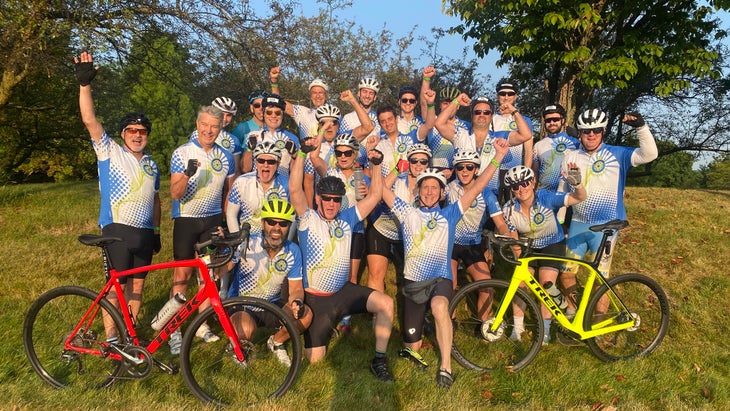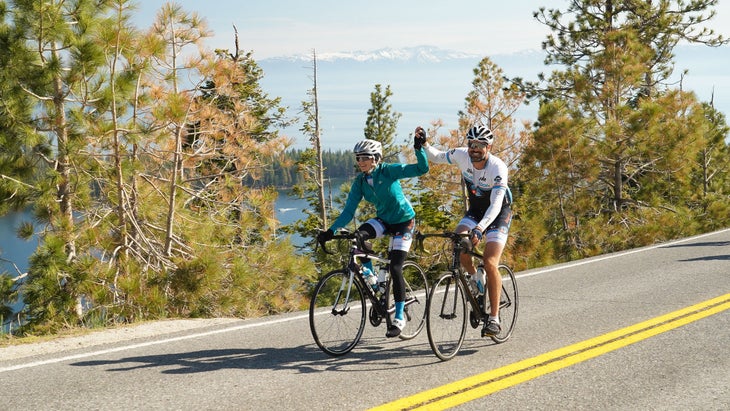When Scott Bauwens’s sister-in-law was first diagnosed with chronic lymphocytic leukemia a few years ago, he set a simple goal. He’d fundraise for The Leukemia and Lymphoma Society (LLS), but only for a single campaign. Then, duty done, he’d go back to business as usual. But during that first campaign, something happened that changed his life. He started to meet leukemia survivors. One after another, they shared their stories.
“As I got more involved,” Bauwens says, “I realized how devastating a cancer diagnosis can be.” He also started to realize just how many members of his own community had been affected. Having spent 25 years working in the agricultural industry, Bauwens wrote on his how he’d “seen this terrible disease tear families apart.” Agricultural workers have a particularly high rate of blood cancer diagnosis due to their constant exposure to synthetic fertilizers, herbicides, and fungicides. And, as Bauwens noted, many struggle to afford the high costs of treatment.
The more he learned, the more it seemed like the disease was everywhere. But he didn’t feel powerless—thanks to LLS providing a way to do something about it.
Why Endurance Races?
Fundraising for any cause, no matter how noble, is tough work. But LLS—the nationwide organization leading blood cancer research, treatment, and advocacy in the U.S.—seems to have cracked the code. For decades, LLS has approached fundraising much like training for an endurance challenge: embracing how it takes a village, how it can be as grueling as it is rewarding, and how you must play the long game for meaningful results.
It turns out that endurance training is an excellent complement for extended engagement in a deeply meaningful and impactful cause that goes beyond fundraising. The physical effort and visible progress of a training cycle keep the fundraising team motivated to keep drumming up donations. And the philanthropic component keeps the athlete accountable to their training. It’s a potent combination—and it works.
Over the last 37 years, LLS’s athletic events and peer-to-peer fundraising campaigns have provided critical levels of funding for new FDA-approved blood cancer treatments. And since 1949, the organization has funded $1.8 billion in medical research. That’s been enough to move the needle on treatment and legislation—and to radically change, improve, and lengthen a lot of lives.

Racing for a Cure
Unfortunately, blood cancers still account for about 60,000 deaths every year in the U.S. alone. And after Bauwens’s first campaign ended, he redoubled his efforts. He started pouring himself into his volunteer work at LLS. He, his wife, and his kids all got involved, fundraising and participating in endurance events for the cause. Today, Bauwens is part of his local LLS board of trustees. In spring 2024, he signed up to participate as a Rookie Challenger in one of LLS’s biggest fundraising events: , an annual distance ride around Lake Tahoe with 100-, 72-, and 35-mile options. In 2024 alone, his team raised more than $302,000.
For the father of two, participating in the ride was enormously satisfying. It felt good to complete a challenge that was far outside his comfort zone. And it felt even better to give back to a cause he cares about. Bauwens points out that everyone he’s met who has received support from LLS, all resoundingly state the same thing: “I wouldn’t be here without the assistance from LLS.”
Found Family
Over the past few decades, the community around LLS’s has ballooned. Today, thousands of attendees fundraise, spectate, and participate in LLS cycling events like , South Carolina’s , and Wisconsin’s —as well as in ski events like . International climbs and destination hikes add to the adventure offerings while run/walk opportunities cover the globe from Disney events to landmark .
The community is fun and supportive, says longtime fundraiser Kevin Shannahan. But it’s also more than that: It’s a family. Shannahan has deeper ties to LLS than most. For one thing, he’s been fundraising for the organization for decades. For another, he wouldn’t be alive today if it weren’t for scientific breakthroughs in blood cancer research. Shannahan, a retired Chicago private equity executive, was first diagnosed with non-Hodgkin’s lymphoma more than 20 years ago. Cutting-edge treatments saved his life. Determined to pay it forward, he pledged to support an organization that funds research for such treatments: LLS. Over the last two decades, he’s helped raise millions of dollars from the saddle of his bike.

Last year, Shannahan was the top individual fundraiser at the , a two-day ride that traces the coast of Lake Michigan. But it’s his team he’s most proud of—and that he loves like family. The group, dubbed Riders of the Storm, has been participating in the ride every year since 2001—and has raised more than $7 million for blood cancer research in that time, tallying $612,000 in 2024 alone.
But for Shannahan, the benefits extend well beyond the money.
“Over the course of 23 years,” he says. “Our team has become members of our extended family.” Together, they’ve experienced joy and sorrow, sprained muscles and even broken bones. The team has celebrated as members have gone into remission. They’ve also mourned and never forgotten loved ones who lost their lives to blood cancer and other forms of cancer. But they keep riding and will never forget those whose lives were cut short. Collectively, the Riders have pedaled enough miles to circumnavigate the globe three times over. And every time the team members get in the saddle, they celebrate all those memories—the good and the bad alike.

The Future
When asked about what’s next for blood-cancer treatments, Shannahan quickly notes how he’s filled with “unrestrained optimism.” He’s confident that the next 25 years will see medical advancements that “few people imagined possible just five to ten years ago.”
Shannahan plans to keep giving back until that future is realized. Not only does he continue to cycle each year; he and his cycling teammates, Michelle Nani and Abby O’Rourke, also launched an annual golf tournament designed to benefit LLS. He gets involved any way he can—and he encourages everyone he meets to do the same. Shannahan only sees positives in the ripple effect of more engagement and a larger donor pool that sees blood cancer research as, “one of the most efficient scientific means to solve many forms of cancer.”
So, if you’ve got a race coming up, consider tying it to the . Go beyond raising funds and support the greater cause by joining Team In Training for your event, or participating in any . Move with purpose. Push your limits. Make an impact. Learn how to become a team member, advocate for patients and their families, or volunteer at .
The (LLS) is the world’s largest nonprofit dedicated to creating a world without blood cancers. The LLS mission: Cure blood cancer and improve the quality of life of all patients and their families. LLS funds lifesaving blood cancer research around the world, provides free information and support services, and advocates for all blood cancer patients seeking access to quality, affordable, coordinated care.

